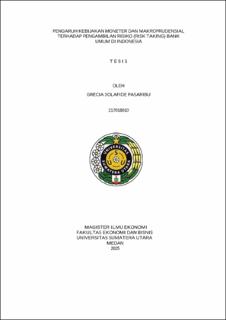Pengaruh Kebijakan Moneter Dan Makroprudensial Terhadap Pengambilan Risiko (Risk Taking) Bank Umum di Indonesia
The Influence of Monetary and Macroprudential Policies on Risktaking Behavior of Commercial Banks in Indonesia

Date
2025Author
Pasaribu, Grecia Solafide
Advisor(s)
Pratomo, Wahyu Ario
Tanjung, Ahmad Albar
Metadata
Show full item recordAbstract
This study aims to determine the influence of monetary and macroprudential policies on the risk-taking behavior of commercial banks in Indonesia. The research employs a quantitative analysis method using a time-series data approach. The data used are time-series data from January 2016 to December 2024 (108 observations). The data source is the Indonesian Financial and Economic Statistics Report obtained from the Financial Services Authority (OJK) website. The method applied in this study is the ARDL (Autoregressive Distributed Lag) model using EViews 12 as the analytical tool. The ARDL method is an econometric approach used to estimate short-run and long-run relationships among economic variables. The results of the study indicate that the BI Rate has a significant negative effect on the risk-taking behavior of commercial banks in Indonesia. The money supply has an insignificant negative effect, while the loanto-value ratio (LTV) and countercyclical capital buffer (CcB) both have insignificant positive effects on risk-taking. Inflation shows a significant positive effect, and the capital adequacy ratio (CAR) also has a significant positive effect on the risk-taking behavior of commercial banks in Indonesia. There are three recommendations for future research. First, future studies are encouraged to use data with a longer time span or to expand the scope of banks (e.g., including Islamic banks and regional development banks) to test the consistency of results. Second, additional variables such as Non-Performing Loans (NPL), bank size, and profitability may be incorporated to provide a more comprehensive understanding of the factors influencing bank risk-taking. Lastly, employing dynamic panel approaches or nonlinear models may enhance the robustness anddepth of the analysis.
Collections
- Master Theses [532]
